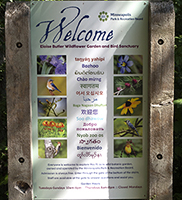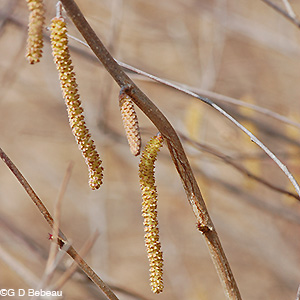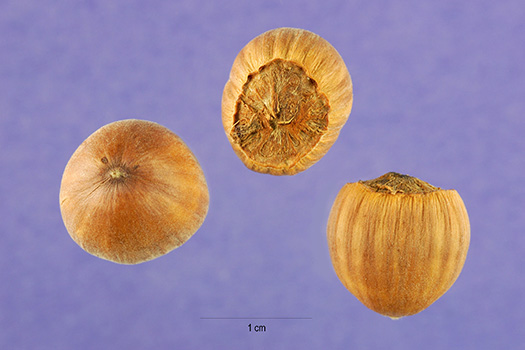Twigs and Branches - March 2023
A web of present and past events
Looking forward to the Garden opening

The date for this event is April 15 by schedule and ??? by nature. With all the snow depth we now have it could be possible the actual opening date will be later. Spring programs at the Garden will soon be announced on the Garden’s website. Check periodically at minneapolisparks.org or subscribe to email updates on the Garden’s page of the Minneapolis Parks website.
When you do get there, check out the new boundary fence arrangement in the upland and the new roof on the Gardener’s shed near the restrooms.
Spring newsletter coming
The spring Fringed Gentian™ will be mailed and emailed the week of March 26th.
Hazelnuts

A number of our native shrubs provide an abundance of attractions throughout the year. The Hazelnut is in that company.
They can maintain an acceptable size for most gardens; the summer foliage is a rich deep green; the fall foliage is a colorful red to mulberry; they produce edible nuts and overwinter, the stems are not bare but tipped with numerous catkins which elongate into the male flowers in the spring. They transplant well, tolerate some shade and don’t demand constant moisture.
What’s not to like? Well, lovers of colorful flowers may give pause. The male flowers are in those catkins and to see the female flowers you need to look carefully for they are a small ovoid bud from which only the bright-red styles of the flower protude - but they do so in early spring when there is little else to look for.


We have two native species in the state - the American Hazelnut, Corylus americana, and the Beaked Hazelnut, Corylus cornuta, which has an elongated husk over the nut. The hazelnut has been used for eating and grinding up to a meal to make a cake-like bread. They taste sweet and similar to the European Filbert. Several other species and numerous varieties are used in commercial nut production. You will find numerous recipes for Hazelnut bread via a Google search.
Below: Nuts of the Beaked Hazelnut. Photo courtesy Steve Hurst.

Eloise Butler's last dilemma.
Who or what would replace her.

Ninety years ago in the spring of 1933 the future of the Wild Flower Garden was decided.
Eloise Butler’s last wish was to preserve the Wild Flower Garden for future generations. In her last letter to Martha Crone in January 1933 she wrote:
“I want also to thank you especially, Mrs. Crone, for what you wrote about the continuance of the wild garden. There’s too much of truth in what you say, but I will soon be able to talk with you about the matter in detail. In this time of depression nothing can be done except to hang on by the skin of one’s teeth. And what, if there hain’t no skin?”(1)
For several years she had been trying to find a means of ensuring the Garden’s survival. One path was to obtain a successor for her position. In a letter to a candidate recommended by Theodore Wirth, Mrs. Pearl Frazer, she wrote:
“For several years I have been trying in vain to find an understudy for the Native Plant Preserve, as I have fully realized that I would not always be able to “Carry on.” A year ago I thought I had found the solution of the problem, but was confronted by an impasse which I still hope can be broken down.” (2)
This impasse was her attempt to convince the University of Minnesota to take over the Garden and use it as an experimental site or together with the Park Board, to make an arboretum in that part of Glenwood Park. Her final rebuff came from Professor C. O. Rosendahl, Chair of the Botany Department who in an abrupt ending paragraph his last letter, which must have hurt Eloise deeply, wrote:
“It is, therefore, clear that the botany department has no right nor legitimate reason for urging the arrangement set forth in your proposal and it will only cause us embarrassment to make any further attempt.” (3)
One would think that something more diplomatic could have come from the man who was on the same Seaside Station research project in 1901 as Eloise, who had signed the original 1907 request to the Park Board to create the Wild Garden, and who was a fellow member of the Minnesota Chapter of the Wild Flower Preservation Society.

Eloise’s dilemma was to fill a very unique and demanding position and in her letter to Mrs. Frazer she pulled no punches about the difficulties of the job.
“Are you willing to accept this position for your life’s work? My salary is $60.00 a month from April to October. This is not a year’s living wage. Pardon my brutal frankness. You have a child to care for. You are young. If you are a widow, you may marry again. In that case what would be the fate of the Preserve? The hours are long. Working by yourself in the woods, far from a telephone, you might not be able to endure the loneliness.”
and she goes on with more facts which would discourage only the most resolute.
But Mrs. Frazer was not resolute - this was not the job she was looking for. Eloise never solved her dilemma before she died on April 10. Fortunately Theodore Wirth knew someone he could approach who had the resolution - Martha Crone - and she served for the next 26 years.
Notes: copies on Friends website - Garden History Archive.
1. Letter to Martha Crone, January 11, 1933
2. Letter to Pearl Frazer September 29, 1932 (see above, 2nd page)
3. Letter of Rosendahl to Butler, October 14, 1931
Below: Two winter views of the Garden taken March 25 after a two inch snowfall, just days before Eloise Butler's return in 1933.
Left - view through the Hemlocks. Right - view of the Garden Office. Both photos by E. F. Pabody.


Previous articles
All selections published in 2023